ISSN ONLINE(2319-8753)PRINT(2347-6710)
ISSN ONLINE(2319-8753)PRINT(2347-6710)
Shikhar Katiyar2, Devendra Patidar3, Shailja Gupta4, R.K.Singh1, Poonam Singh1*
|
| Corresponding author Dr. Poonam Singh, CSIR-Central Drug Research Institute, B.S. 10/1, Sector 10, Jankipuram Extension, Sitapur Road, Lucknow-226031, India. |
| Related article at Pubmed, Scholar Google |
Visit for more related articles at International Journal of Innovative Research in Science, Engineering and Technology
Since the beginning of human civilization, a number of Indian medicinal plants have been used in the traditional system of medicine (Ayurveda), aiming to maintain health and to cure diseases. Oxidative stress has emerged as a key role player in the pathogenesis and pathophysiology of several diseases in humans as well as in experimental animal models. As plants produce a lot of antioxidants they can represent a source of novel compounds with promising antioxidant activity. Nowadays there has been an increasing interest worldwide to identify antioxidant compounds that are pharmacologically active with less or no side effects. In the present paper six plants (Saraca indica, Lantana camara, Glycyrrhiza glabra, Vaccinium oxycoccos, Cinnamomum zeylanicum, Acacia arabica) are viewed for their historical, morphological, phytochemical, and pharmacological aspects. These plants exhibit strong antioxidant activity that can explain their uses in traditional medicines in the past as well as present.
Keywords |
| medicinal plants, ROS, disorders, antioxidant, pharmacological. |
INTRODUCTION |
| Experimental evidence suggests that free radicals and reactive oxygen species (ROS) can be involved in high number of disorders such as arthritis, connective tissue disorders, liver disorders, neurodegenerative disorders, diabetes, chronic inflammation, cancer and in the process of ageing (Waris and Ahsan, 2006). Several endogenous and exogenous causes like metabolism, chemicals and ionizing radiation leads to the formation of ROS. Oxidative stress occurs when there is an imbalance between generation of ROS and antioxidants defense mechanisms of a cell or a tissue. This causes irreversible oxidation of DNA, proteins and lipids, leading to the inactivation of many enzymes and cell death. Recent studies have proposed that cellular reactive oxygen species may mediate the mitochondria-initiated apoptosis (Jing et al., 2002; Wang et al., 2004). Antioxidants provide protection to the living organisms from the damage caused by uncontrolled production of ROS. Now-a-days, traditional medicines all over the world are revaluated by an extensive activity of research on different plant species and their therapeutic principles. The 21st century has seen a paradigm shift towards therapeutic evaluation of herbal products in oxidative stress diseases by carefully synergizing the strengths of the traditional systems of medicine with that of the modern concept of evidence-based medicinal evaluation, standardization of herbal products and randomized placebo controlled clinical trials to support clinical efficacy. In the present review six plants (Saraca indica, Lantana camara, Glycyrrhiza glabra, Vaccinium oxycoccos, Cinnamomum zeylanicum, Acacia arabica) are viewed in detail for their historical, morphological, phytochemical, and pharmacological aspects. |
II. SOME PLANTS WITH ANTIOXIDANT ACTIVITY |
| Among the different plants species six of them have been specifically investigated for their well demonstrated antioxidant activity: A. Saraca indica Species- Saraca indica Family - Fabaceae Genus - Saraca Synonyms- Saraca asoca Linnaeus Vernicular names- Sanskrit- Sita- Ashoka; Hindi- Vand ichitrah; English- Ashoka; Tamil- Asogam; Marathi- Jasundi; Malayalam- Asokam; Telugu- Vanjulamu; Bengali- Oshok; Kannada- Ashanke, Kenkalimara. Habitat- Saraca indica is grown in all over India and it occur up to the altitude 600 metres. It is cultivated in many gardens because of its decorative orange red flowers and evergreen beautiful foliage. Parts used- Leaves, Flowers, Fruits, Bark. Morphological characteristics- Leaves– It is a peripinnate, alternate, distichous and 7-30 cm long and its petiolule 0.1-0.6 cm long and opposite leaflets, 4-6 pairs, narrow elliptic-oblong or lanceolate, and its apex acute to acuminate, base acute to rounded or subcordate, glabrous, midrib raised above and tertiary nerves reticulate [1]. |
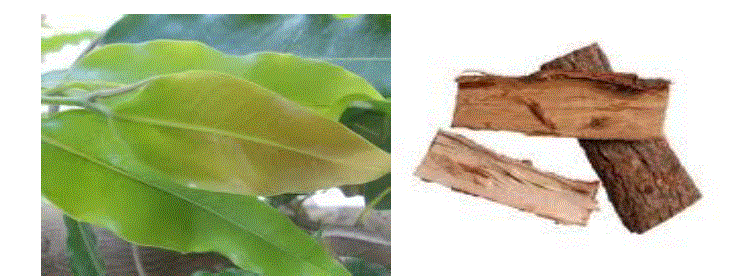 |
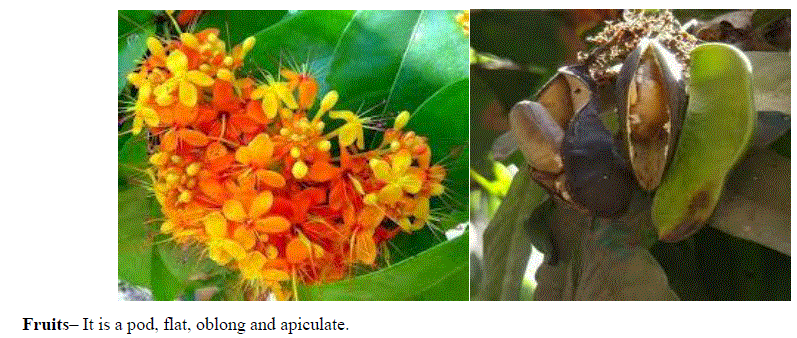 |
| Chemical constituents– The bark of plant contain epicatechin, procyanidin p2, 11’-deoxyprocyanidin B, catechin, 24- methyl-cholesta-5-en-3p-ol, 24-ethycholesta-5, 22-dien-33-ol, leucopelargonidin-3-O-p-Dglucoside, leucopelargonidin and leucocyanidin. The flower part of plant contain Oleic, linoleic, palmitic and stearic acids, P-sitosterol, quercetin, kaempferol-3-0-P-D-glucoside, quercetin-3-0-P-D-glucoside, apigenin-7-0-p-D-glucoside, pelargonidin-3,5- diglucoside, cyanidin-3,5-diglucoside, palmitic, stearic, linolenic, linoleic, p and y sitosterols, leucocyanidin and gallic acid. Seed and Pod contains oleic, linoleic, palmitic and stearic acids, catechol, (-) epicatechol and leucocyanidin. Five lignan glycosides, lyoniside, nudiposide, 5-methoxy-9-β-xylopyranosyl-(−)-isolariciresinol, icariside E3, and schizandriside, and three flavonoids, (−)-epicatechin, epiafzelechin-(4β→8)-epicatechin and procyanidin B2, together with β-sitosterol glucoside, were isolated from dried bark [1]. Pharmacological antioxidant activity: Many herbs and spices have been shown to impart antioxidant effects in food. There are several reports that the extracts (ethanolic, hydroalcoholic and acetone) of Saraca indica bark showed the antioxidant activity. Panchawat and Sisodia (2010) studied in vitro antioxidant activity of Saraca asoca roxb. de wilde stem bark by using DPPH (1,1,diphenyl-2 picryl hydrazyl) in-vitro model) and reported that the antioxidant property of the various extracts may be due to high phenolic component [2]. Evaluation of antioxidant and antihyperglycemic activity of the petroleum ether, chloroform and methanolic extract of Saraca asoca De wild leaves by streptozotocin induced model in mice and in vitro DPPH and H2O radical scavenging model has been reported by Kumar et al. (2012). They concluded that the oral administration of the extract caused a significant reduction in blood glucose level in diabetic mice and showed significant antioxidant activity [3]. Comparative study of the Saraca indica and Pterospermum acerifolium with ascorbic acid in dose dependent manner on the basis of antioxidant activity by in vitro DPPH model was carried out by Amin et al.(2012). They determined that the processed Saraca indica and pterospermum acerifolium exhibited potential antioxidant properties [4]. Patel et al., (2013) studied cardioprotective effect of saraca indica against cyclophosphamide induced cardiotoxicity in rats and determined that the free radical generated during treatment with cardioprotective cause membrane injury. The biochemical, ECG and histopathology reports supported the cardioprotective effect of Saraca indica which could be attributed to antioxidant activity [5]. B. Lantana Camara Species- L.camara Family- Verbenaceae Genus- Lantana Synonyms- Lantana aculeate L. Vernacular names- Sanskrit- Chaturangi,Vanacchedi; Hindi- Raimuniya; English- Lantana; Tamil- Unnichedi; Marathi- Tantani,Ghaneri; Kannada- Kakke, Natahu; Telugu- Pulikampa; German- Wandelroeschen. |
| Habitat– The species is native to India and grows in tropical and subtropical regions, wild and cultivated in India like Madhya Pradesh, Gujarat, Maharashtra, Andra Pradesh and Tamil Nadu etc. It also grows also in Mexico, Central America, Bahamas, Colombia and Venezuela. L. camara is a low erect or vigorous shrub which can grow to 2-4 meters in height. Parts used– Flowers, Leaves, Stem, Fruits, Seeds. Morphological characteristics– Leaves- It is ovate or ovate oblong, 2-10 cm long and 2-6 cm wide, arranged in opposite pairs. Leaves are bright green, rough, finely hairy, with serrate margins and emit a pungent odour when crushed. |
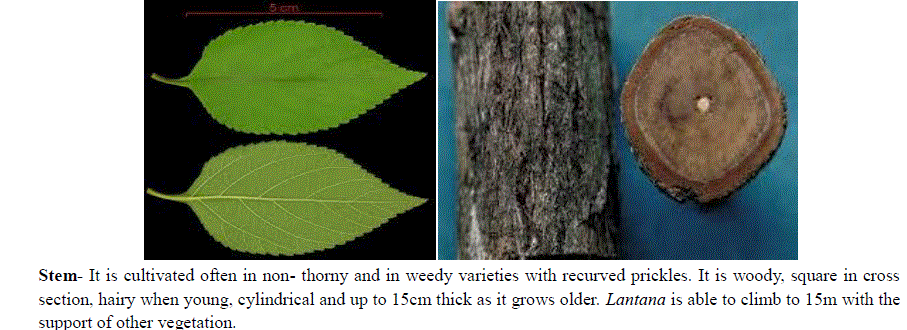 |
| Seeds- Mature plants produce up to 12,000 seeds annually. Seed germination occurs when sufficient moisture is present. Germination is reduced by low light conditions. The root system is very strong with a main tap root and a mat of many shallow side roots. |
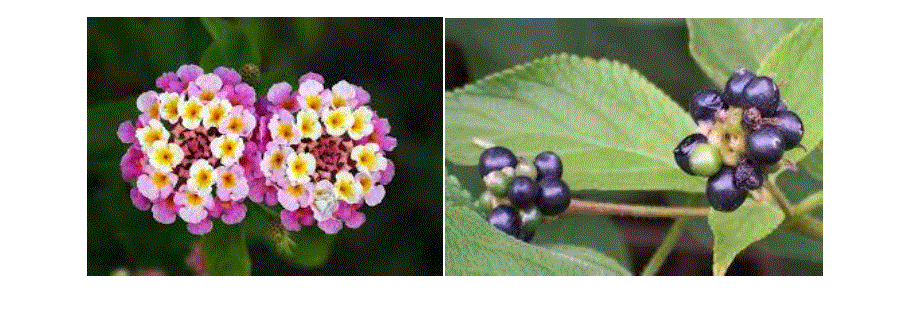 |
| Chemical constituent- The root and flowers of Lantana camara L. contains iridoids: theveside, theviridoside, geniposide, 8-epiloganin, lamiridoside, shanzhside methyl ester, triterpenoids, oleanolic acid, lantanolic acid, 22β-Oangeloyl- lantanoiic acid, 22β-O-angeloyl-oleanolic acid, 22β-O-senecioyl-oleanolic acid, 22β-hydroxyoleanolic acid, 19α-hydroxyursolic acid, lantaiursolic acid, naphthoquinones: diodantunezone, isodiodantunezone, 6- methoxydiodantunezone, 7-methoxydiodantunezone, 6-methoxyisodiodantunezone, 7-methoxyisodiodantunezone, besides, it also contains lantanoses A and B [6]. The stem and leafs contains triterpenoids: lantadenes A, B, C, D, lantic acid, camaric acid, camarinic acid, camaryolic acid, methylcamaralate, camangeloyl acid, lantanolic acid, lantabetulic acid, oleanolic acid, oleanonic acid, betulonic acid, betulic acid, lantalonic acid, 3-ketourosolic acid, lantoic acid, lantanone, flavonoids, lantanoside, linaroside, phenylethanoid glycosides, acteoside [6]. Pharmacological antioxidant activity- Ethanolic extract of Lantana camara exhibited significant antioxidant activities using in vitro DPPH radical scavenging assay and nitric oxide free radical scavenging assay. Mayce et al., (2011) determined that the extract of the plant exhibited potent antioxidant activity and it decreased the extent of lipid peroxidation in the kidneys of urolithic rats [7]. The leaves of Lantana camara contains Lantadenes, these are the pentacyclic triterpenoids. In vitro antioxidant activity and free radical scavenging capacity of lantadene A was evaluated by Chong et al., (2012) using established in vitro models such as ferric reducing antioxidant power (FRAP), 2,2-diphenyl-picryl-hydrazyl (DPPH), hydroxyl radical (OH), nitric oxide radical (NO), superoxide anion scavenging activities and ferrous ion chelating assay. Interestingly, Lantadene showed considerable in vitro antioxidant, free radical scavenging capacity activities in a dose dependent manner when compared with the standard NO scavenging, superoxide anion radical scavenging and ferrous ion chelating assay [8]. Mahdi et al., (2012) screened the extract for possible antioxidant activity by free radical scavenging activity, DPPH, xanthine oxidase inhibition activity and Griess– Ilosvay method. Their results showed significant antioxidant activity of the leaves extract of L. camara that was more effective than the other parts [9]. The methanolic extract of leaves of L. camara showed the antioxidant activity and the level of superoxide dismutase (SOD), catalase (CAT) and glutathione (GSH), were evaluated in normal, ulcer control and drug treated group. Thamotharan et al., (2010) determined the dose dependent antioxidant activity of the extract in all three antiulcer models(superoxide dismutase, catalase, glutathione) [10]. C. Glycyrrhiza glabra Species- G. glabra Family- Leguminosae Genus- Glycyrrhiza Synonym- Glycyrrhiza Glandulifera |
| Vernacular Names- Sanskrit- Yashiti-madhu, Madhuka; English- Sweet wood, liquorice; Hindi- Mithilakdi, Mulathee, Kubas-susa, Jethi-madh; Bengali- Yashto-madhu; Guajarati and Marathi- Jash-timadh, Madhu; Telgu- Yashti-Madhukam, Athimathuram; Tamil- Ati-Maduram (root), Athimathurappal; Kannada- Jestamaddu [11]. Habitat- Glycyrrhiza glabra is a hard herb or under shrub attaining a height up to 6ft. It is distributed in southern Europe, Syria, Iran, Afghanistan, Russia, China, Pakistan, and N. India. And it is cultivated in Russia, UK, USA, France, Germany, Spain, China, N. India (Punjab and Sub-Himalayan tracts) and large scale commercial cultivation is seen in Spain, Sicily and England [11]. Part Used- Peeled Roots, Leaves, Flowers. Morphological characteristics- Leaves- It is a multi-foliate and impair pinnate. Flowers- |
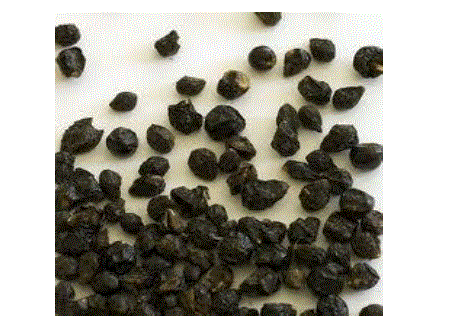 |
| Flowers- It is a axillary spikes, lavender to violet in colour. Roots- The diameter of the root varies from 0.75 to 2.5cm, grey-brown exterior and yellow interior and externally it is longitudinally wrinkled with patches of cork with a characteristic pleasant sweet taste [11]. Chemical Constituents- The chief constituent of liquorice is glycyrrhizin, which is present in the drug in the form of the potassium and calcium salts of glycyrrhizic acid, glycyrrhizinic acid, glabrin A and B, glycyrrhetol, glabrolide, isoglabrolide, isoflavones, coumarins, triterpene sterols etc. Liqourice also contains glucose (up to 3.8%), sucrose (2.4 to 6.5%), bitter principles, resins, mannite, asparagines (2 to 4%) and fat (0.8%) [11]. Pharmacological Antioxidant Activity- The relative antioxidant activity of ethanolic extracts of Centella asiatica, Punica granatum, Glycyrrhiza glabra Linn. Areca catechu was determined by Ashawat et al., (2007). Using individual extract as well as their combination with equal amount of ascorbic acid, increased absorbance of the reaction mixture indicated increased antioxidant activity via reducing power with reference to equal amount of standard ascorbic acid [12]. Antioxidant and antiulcer activity of GutGardTM that is a standardized extract of Glycyrrhiza glabra using in vitro and in vivo model like pylorus ligation, cold-restraint stress and indomethacin induced gastric mucosal injury for antiulcer activity and Oxygen Radical Absorbance Capacity (ORAC) assay for antioxidant activity. Mukherjee et al., (2010) determined the GutGardTM exhibited potent antiulcer and antioxidant activity [13]. Kanimozhi et al.,(2011) determined the ethanolic extract of G. glabra leaves showed potent antioxidant activity in 1,4-dichlorobenzene induced liver carcinogenesis in albino rats [14]. The essential oil of G. glabra was obtained by hydrodistillation and its phytochemical composition was determined by Gas Chromatography–Mass Spectrometry (GC-MS) analysis. Enas (2013) determined the oil of G. glabra was showed antioxidant activity by in vitro DPPH model in dose dependent manner and also showed antifungal, anticancer, and antiaflatoxigenic activity [15]. The methanolic root extract of G. glabra showed antimutagenic activity by in vivo DNA fragmentation test and antioxidant activity by use of β-carotene spray against cyclophosphamide drug. Al-terehi et al.,(2012) determined the extract inhibit accumulation effect of mutagenicity and oxidation activity of the cyclophosphamide [16]. D. Vaccinium oxycoccos Species- V. oxycoccos Family - Ericaceae Genus- Vaccinium Synonym- V. erythrocarpum, V. macrocarpon, V. microcarpum. Vernacular names- Sanskrit- karmard; Hindi- karaunada; English- Cranberry; Tamil- kalakai; Marathi- karvinda; Malayalam- karakka; Telugu- Vakkay; Bengali- karamcha; Kannada- karjige. Habitat- V. oxycoccosis a very hardy and drought tolerant plant, it thrives well throughout the tropical and subtropical climates, wild and cultivated in India (like Madhya Pradesh, Gujarat, Maharashtra, Andra Pradesh, Tamil Nadu etc.). It grows also in Japan, Central America, Srilanka, Myanmar, and Malacca. Heavy rainfall and waterlogged conditions are not desirable. It can be grown on a wide range of soils including saline and sodic soils. V. oxycoccosis is commonly grown from seeds. Vegetative methods- air-layering and stem (hard wood) cuttings are feasible but not very common. Fresh seeds are sown in nursery during August-September. One year old seedlings are transplanted, air-layering is very successful. Parts used- Leaves, Flowers, Fruits. Morphological characteristics– Leaves- The leaves are oblong and conical |
| Family- Lauraceae Genus- Cinnamomum Species- C. saigonicum, C. laurus, C. aromaticum Synonyms- C. Saigonicum, C. Cassia, C. Aromaticum, C. Laurus, C. Verum. Vernacular Names- English- Cinnamomum; Sanskrit- Gudetvak; Hindi, Punjabi, Gujrati, Bengali, Marathi and kannada- Dalacini; Telgu, Tamil- Lowangapatta; Malayalam- Kulit manis; Germani- Zimmt; Indonesia- Kayu Manis; Chinese- Yuh/Juh. Habitat- Indigenous to Ceylon and S.India, also in some parts of Burma in tropical and Subtropical regions, at a temperature of 32°c and above. Part used- Bark, Leaves. Morphological Characteristics- It is a hardy plant, raised on an annual rainfall of 200-250cm. It is a bushy evergreen tree. Bark- The dried bark of the shoot of trees is deprived of cork and most of its cortex. The individual pieces of bark are not more than 0.5 mm thick and of a dull pale brown in colour. |
| Leaves- The leaves are kind of oval in shape and are around 5-20 cm long. Chemical constituents- The oil from bark and leaves contain 70-80% euginol and rest is cinnamic aldehyde. The oil is yellow in colour and lighter than water. Cinnamon sticks and whole bark contain 77.0 mmol/100ga. Antioxidant content and also contain terpenes, mucilage and its active Components are cinnamaldehyde (tranquilizer) and 2- Methoxycinnamaldehyde [23]. Pharmacological antioxidant activity- Cinnamon is reported for its anti-oxidant, anti-ulcer, anti-microbial, antidiabetic and anti-inflammatory activity in scientific literature. The active principles are phenolics, sterols, tannins, bioflavanoids, present as the chemical constituent are responsible for anti-oxidant activity of the plant. It was found safe in acute toxicity studies in animals. Vaibhavi et al., (2010) reported that cinnamon contains a good amount of phenolic antioxidants. This counteracts the damaging effects of free radicals and may protect against mutagenesis. It has also been reported that mitochondrial dysfunction, decrease in ATP formation, oxidation and free radical generation can fasten the aging process [26]. Murcia et al., (2004) have investigated the antioxidant properties of cinnamon compared with those of the common food antioxidants, butylated hydroxyanisole (BHA) (E-320), butylated hydroxytoluene (BHT) (E-321) and propyl gallate (E-310). The cinnamon exhibited a higher percentage of inhibition of oxidation as tested by the lipid peroxidation assay. It was a better superoxide radical scavenger with capacity approximately equal to that of propyl gallate. It was also found that one-half millilitre of cinnamon leaf has free radical scavenging ability with an EC50 of 53μ/ml and has a total phenolic content of 420 mg/g as the major chemical composition [27]. |
| Chemical constituents- A. arabica contains gallic acid, m-digallic acid, chlorogenic acid, gallolyated flavan-3, 4-diol, robidandiol (7,3,4,5-tetrahydroxyflavan-3-4-diol), androstene steroid, D-pinitol carbohydrate, and catechin-5-galloyl ester [29]. Leaves- Leaves contain 2.2–2.6% N, 16.9–20.0% NDF (Neutral Detergent Fiber), 13.3–14.1% ADF (Acid Detergent Fiber), 7.2–8.7 MJ/kg energy, 10–21% crude fibre and 6–9% condensed tannins [28]. Seeds- Seeds contain 1.6–2.2% N, 10 MJ/kg energy, 12–18% crude fibre and 4–7% condensed tannins [28]. Pharmacological antioxidant activity- Antioxidant activity of ethyl acetate soluble fraction of A. arabica bark by in vitro lipid peroxidation model was carried out by tertiary butyl hydroperoxide induced lipid peroxidation and the most active fraction were identified by TLC and in vivo experiment in most active fraction were carried out with 50, 100 and 150 mg/kg oral dose in carbon tetra chloride induced hepatotoxicity in rats and it is hypothesized that flash chromatographic fraction of ethyl acetate extract exhibited maximum activity with in vitro lipid peroxidation and 150 mg/kg dose of carbon tetra chloride shows marked liver protection in in vitro model [30]. |
III.CONCLUSION |
| There are evidences suggesting that free radicals and reactive oxygen species (ROS) can be involved in high number of diseases including cancer. Many synthetic antioxidants used in processed foods exhibit side effects and are carcinogenic (Ito et al. 1983, Mishra et al. 2011). Several indigenous antioxidants may be useful in preventing the deleterious effects of oxidative stress. This has led to considerable interest in assessing the antioxidant capacity of foods, botanicals and other nutritional antioxidant supplements. In the present work Saraca indica, Lantana camara, Glycyrrhiza glabra, Vaccinium oxycoccos, Cinnamomum zeylanicum, Acacia arabica are reviewed for their antioxidant properties. The phytochemical analysis of these medicinal plants have revealed a large number of compounds including flavonoids and phenolics which have shown potent antioxidant activity. These compounds have been used as anti-oxidant, ant-carcinogenic, antifungal, antibacterial, anti-spasmodic, anti-inflammatory and anti-diabetic. |
References |
|